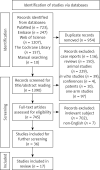Clinical evaluation of maxillary sinus floor elevation with or without bone grafts: a systematic review and meta-analysis of randomised controlled trials with trial sequential analysis
- PMID: 38757030
- PMCID: PMC11094833
- DOI: 10.5114/aoms/174648
Clinical evaluation of maxillary sinus floor elevation with or without bone grafts: a systematic review and meta-analysis of randomised controlled trials with trial sequential analysis
Abstract
Introduction: Our goal was to systematically review the current evidence comparing the relative effectiveness of two maxillary sinus floor elevation (MSFE) approaches (internal and external) without bone grafts with that of conventional/grafted MSFE in patients undergoing implantation in the posterior maxilla.
Material and methods: Medical databases (PubMed/Medline, Embase, Web of Science, and Cochrane Library) were searched for randomised controlled trials published between January 1980 and May 2023. A manual search of implant-related journals was also performed. Studies published in English that reported the clinical outcomes of MSFE with or without bone material were included. The risk of bias was assessed using the Cochrane Handbook Risk Assessment Tool. Meta-analyses and trial sequence analyses were performed on the included trials. Meta-regression analysis was performed using pre-selected covariates to account for substantial heterogeneity. The certainty of evidence for clinical outcomes was assessed using GRADEpro GDT online (Guideline Development Tool).
Results: Seventeen studies, including 547 sinuses and 696 implants, were pooled for the meta-analysis. The meta-analysis showed no statistically significant difference between MSFE without bone grafts and conventional MSFE in terms of the implant survival rate in the short term (n = 11, I2 = 0%, risk difference (RD): 0.03, 95% confidence intervals (CI): -0.01-0.07, p = 0.17, required information size (RIS) = 307). Although conventional MSFE had a higher endo-sinus bone gain (n = 13, I2 = 89%, weighted mean difference (WMD): -1.24, 95% CI: -1.91- -0.57, p = 0.0003, RIS = 461), this was not a determining factor in implant survival. No difference in perforation (n = 13, I2 = 0%, RD = 0.03, 95% CI: -0.02-0.09, p = 0.99, RIS = 223) and marginal bone loss (n = 4, I2 = 0%, WMD = 0.05, 95% CI: -0.14-0.23, p = 0.62, no RIS) was detected between the two groups using meta-analysis. The pooled results of the implant stability quotient between the two groups were not robust on sensitivity analysis. Because of the limited studies reporting on the visual analogue scale, surgical time, treatment costs, and bone density, qualitative analysis was conducted for these outcomes.
Conclusions: This systematic review revealed that both non-graft and grafted MSFE had high implant survival rates. Owing to the moderate strength of the evidence and short-term follow-up, the results should be interpreted with caution.
Keywords: bone grafts; dental implants; maxillary sinus floor elevation; meta-analysis; trial sequential analysis.
Copyright: © 2024 Termedia & Banach.
Conflict of interest statement
The authors declare no conflict of interest.
Figures





















Similar articles
-
Histological, radiological, and clinical outcomes of sinus floor elevation using a lateral approach for pre-/post-extraction of the severely compromised maxillary molars: a study protocol for a randomized controlled trial.Trials. 2021 Jan 28;22(1):101. doi: 10.1186/s13063-021-05047-5. Trials. 2021. PMID: 33509257 Free PMC article.
-
Outcomes of maxillary sinus floor augmentation without grafts in atrophic maxilla: A systematic review and meta-analysis based on randomised controlled trials.J Oral Rehabil. 2019 Mar;46(3):282-290. doi: 10.1111/joor.12753. Epub 2018 Dec 26. J Oral Rehabil. 2019. PMID: 30537184
-
Piezoelectric bone surgery for lateral sinus floor elevation compared with conventional rotary instruments: A systematic review, meta-analysis and trial sequential analysis.Int J Oral Implantol (Berl). 2020;13(2):109-121. Int J Oral Implantol (Berl). 2020. PMID: 32424379
-
Lateral sinus floor elevation without grafting materials. Individual- and aggregate-data meta-analysis.J Craniomaxillofac Surg. 2018 Sep;46(9):1616-1624. doi: 10.1016/j.jcms.2018.06.012. Epub 2018 Jun 15. J Craniomaxillofac Surg. 2018. PMID: 29980356
-
Bone vitality and vascularization of mandibular and maxillary bone grafts in maxillary sinus floor elevation: A retrospective cohort study.Clin Implant Dent Relat Res. 2023 Feb;25(1):141-151. doi: 10.1111/cid.13142. Epub 2022 Oct 10. Clin Implant Dent Relat Res. 2023. PMID: 36214357 Free PMC article.
Cited by
-
Impact of Collagenated and Non-Collagenated Deproteinized Bovine Bone Mineral on Schneiderian Membrane Integrity in Rabbits.Dent J (Basel). 2025 Jan 2;13(1):19. doi: 10.3390/dj13010019. Dent J (Basel). 2025. PMID: 39851595 Free PMC article.
-
Evaluation of accuracy and membrane perforation in robotic-assisted implant surgery for transalveolar sinus floor elevation: a retrospective case series.BMC Oral Health. 2025 Apr 3;25(1):474. doi: 10.1186/s12903-025-05848-z. BMC Oral Health. 2025. PMID: 40181381 Free PMC article.
-
Clinical Indications and Outcomes of Sinus Floor Augmentation With Bone Substitutes: An Evidence-Based Review.Clin Implant Dent Relat Res. 2025 Feb;27(1):e13400. doi: 10.1111/cid.13400. Epub 2024 Oct 17. Clin Implant Dent Relat Res. 2025. PMID: 39415739 Free PMC article. Review. No abstract available.
-
Efficacy of Different Materials for Maxillary Sinus Floor Augmentation With Lateral Approach. A Systematic Review.Clin Implant Dent Relat Res. 2025 Jun;27(3):e70053. doi: 10.1111/cid.70053. Clin Implant Dent Relat Res. 2025. PMID: 40405532 Free PMC article.
References
-
- Hirschfeld L, Wasserman B. A long-term survey of tooth loss in 600 treated periodontal patients. J Periodontol 1978; 49: 225-37. - PubMed
-
- Botticelli D, Berglundh T, Lindhe J. Hard-tissue alterations following immediate implant placement in extraction sites. J Clin Periodontol 2004; 31: 820-8. - PubMed
-
- Tatum H Jr. Maxillary and sinus implant reconstructions. Dent Clin North Am 1986; 30: 207-29. - PubMed
-
- Boyne PJ, James RA. Grafting of the maxillary sinus floor with autogenous marrow and bone. J Oral Surg 1980; 38: 613-6. - PubMed
-
- Taschieri S, Lolato A, Testori T, Francetti L, Del Fabbro M. Short dental implants as compared to maxillary sinus augmentation procedure for the rehabilitation of edentulous posterior maxilla: three-year results of a randomized clinical study. Clin Implant Dent Relat Res 2018; 20: 9-20. - PubMed
Publication types
LinkOut - more resources
Full Text Sources
Miscellaneous
